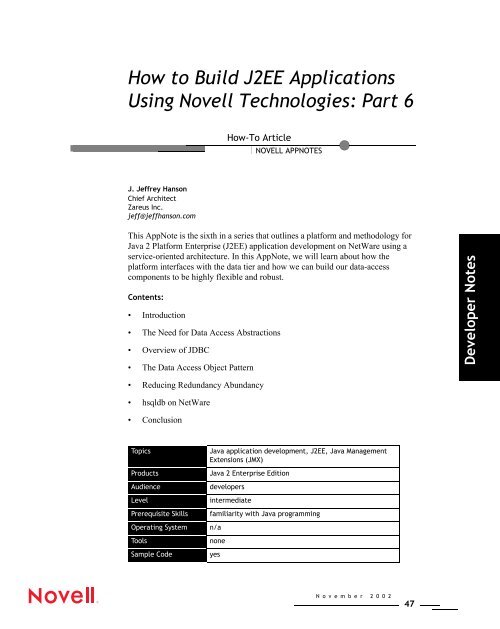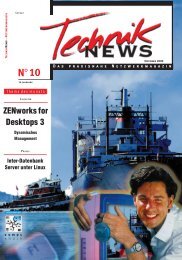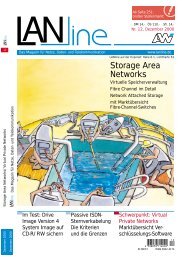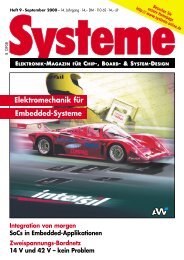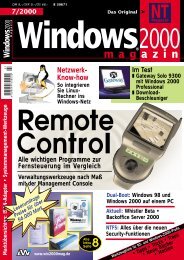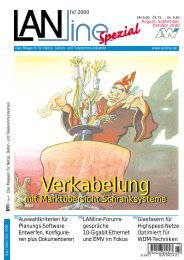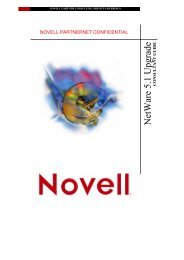Developer Notes - ITwelzel.biz
Developer Notes - ITwelzel.biz
Developer Notes - ITwelzel.biz
You also want an ePaper? Increase the reach of your titles
YUMPU automatically turns print PDFs into web optimized ePapers that Google loves.
How to Build J2EE Applications<br />
Using Novell Technologies: Part 6<br />
How-To Article<br />
NOVELL APPNOTES<br />
J. Jeffrey Hanson<br />
Chief Architect<br />
Zareus Inc.<br />
jeff@jeffhanson.com<br />
This AppNote is the sixth in a series that outlines a platform and methodology for<br />
Java 2 Platform Enterprise (J2EE) application development on NetWare using a<br />
service-oriented architecture. In this AppNote, we will learn about how the<br />
platform interfaces with the data tier and how we can build our data-access<br />
components to be highly flexible and robust.<br />
Contents:<br />
• Introduction<br />
• The Need for Data Access Abstractions<br />
• Overview of JDBC<br />
• The Data Access Object Pattern<br />
<strong>Developer</strong> <strong>Notes</strong><br />
• Reducing Redundancy Abundancy<br />
• hsqldb on NetWare<br />
• Conclusion<br />
Topics<br />
Products<br />
Audience<br />
Level<br />
Prerequisite Skills<br />
Operating System<br />
Tools<br />
Sample Code<br />
Java application development, J2EE, Java Management<br />
Extensions (JMX)<br />
Java 2 Enterprise Edition<br />
developers<br />
intermediate<br />
familiarity with Java programming<br />
n/a<br />
none<br />
yes<br />
N o v e m b e r 2 0 0 2<br />
47
Introduction<br />
This is the sixth in a series of App<strong>Notes</strong> outlining a platform and methodology for<br />
Java 2 Platform Enterprise Edition (J2EE) application development on NetWare<br />
using a service-oriented architecture.<br />
In the previous AppNote, we thoroughly examined the platform kernel relating to<br />
services that JMX offers to empower our platform. In this AppNote, we will<br />
discuss how our platform interfaces with the data tier and how we can build our<br />
data-access components to be highly flexible and robust.<br />
The Need for Data Access Abstractions<br />
The data tier of enterprise application development offers integration and access<br />
to all services and data that are prevalent in enterprise applications and systems,<br />
including relational databases, directory services, and legacy systems.<br />
<strong>Developer</strong> <strong>Notes</strong><br />
Direct access to a data source links business logic and implementation details of<br />
an external resource. If the API to that resource changes, it will be necessary to<br />
also change your application source code throughout the application, resulting in a<br />
significant testing and maintenance burden.<br />
However, a data access framework that is able to abstract data resources insulates<br />
callers from those resource changes. A data access framework presents a<br />
vendor-neutral interface to the caller; in addition, it manages the details of passing<br />
service requests from the caller to the business tier. This design is particularly<br />
beneficial because ultimately a single service request may access multiple data<br />
resources. The replacement of an existing data resource will also cause the<br />
existing data access class to be replaced, which then presents the new service to<br />
the caller. It is effortless for a system design to evolve with time when the<br />
business tier (with an abstract data-access layer) is isolated.<br />
Overview of JDBC<br />
JDBC technology allows you to access nearly any record-oriented data source<br />
from the Java programming language. It offers cross-DBMS connectivity to an<br />
extensive collection of SQL databases, and also provides access to non-relational<br />
data sources, such as spreadsheets or flat files.<br />
The JDBC API is the industry standard database-connectivity mechanism<br />
between the Java programming language and relational databases. JDBC allows<br />
developers the full advantage of Java’s “Write Once, Run Anywhere” promise for<br />
cross-platform applications that require access to enterprise data. A<br />
JDBC-enabled application allows a developer to effortlessly connect all available<br />
relational data, even in a heterogeneous environment.<br />
48<br />
www.novell.com/appnotes
The JDBC API is offered as a core part of the Java 2 platform and makes it<br />
possible to establish a connection with a relational database, send SQL statements<br />
to the database and process the results.<br />
The Data Access Object Pattern<br />
Code dependent on specific features of data resources connects business logic and<br />
data access logic. Therefore, replacing or modifying an application’s data<br />
resources is very complicated.<br />
The Data Access Object (DAO) pattern reduces the complications arising from<br />
tightly-coupled business logic and data access code by abstracting data sources to<br />
enable transparent access to the data. The DAO pattern has the following<br />
advantages:<br />
• Separates a data resource’s interface from its data access implementation.<br />
• Adapts a specific data resource’s access API to a generic interface.<br />
• Allows data access implementation to adjust independently from the code that<br />
uses the DAO.<br />
• Offers access to a particular data resource without coupling the resource’s<br />
API to the business logic.<br />
• Permits application developers or deployment engineers the choice of a data<br />
access mechanism with no changes to the program code.<br />
This approach allows a developer access to a data source only in terms of its DAO<br />
interface. Based on configuration data, an application uses a factory object to<br />
select the DAO implementation at runtime.<br />
<strong>Developer</strong> <strong>Notes</strong><br />
A DAO interface has at least one concrete class that implements the interface for a<br />
specific type of data source. To add a new type of data source, an application<br />
developer simply follows the steps listed below:<br />
1. Create a class that implements the DAO interface for the new data<br />
source type.<br />
2. Specify the implementing class’s name in a meta-data configuration source.<br />
3. Facilitate a re-initialization by the client service, which causes the creation of<br />
an instance of the new DAO class by the factory, which the application will<br />
now use.<br />
Figure 1 shows the implementation of the DAO design pattern for a DAO that<br />
accesses data for a business-contacts resource. Notice how the factory is used to<br />
select the DAO implementation.<br />
N o v e m b e r 2 0 0 2<br />
49
AddressDAO<br />
ContactsDAO<br />
Factory<br />
uses<br />
accesses<br />
selects/creates<br />
hsqldb<br />
Data Source<br />
PersonDAO<br />
Contact<br />
hsqldb<br />
ContactsDAO<br />
Client<br />
Service<br />
accesses<br />
Implements<br />
accesses<br />
CompanyDAO<br />
<br />
ContactsDAO<br />
accesses<br />
Figure 1: Implementation of the DAO design pattern for a DAO that accesses data for a<br />
business-contacts resource.<br />
<strong>Developer</strong> <strong>Notes</strong><br />
The DAO Interface<br />
Using the DAO pattern, a developer accesses a data source only in terms of its<br />
DAO interface. This approach shields the application or client service from<br />
modifications to the underlying data source. The following is an example of a<br />
DAO interface for a DAO that abstracts data and functionality for a data source<br />
that stores information for business contacts:<br />
public interface ContactsDAO<br />
{<br />
public Contact getContact(String personID,<br />
String addressID,<br />
String companyID)<br />
throws DAOException;<br />
public String addContact(String addStr)<br />
throws DAOException;<br />
public void modifyContact(String contactID,<br />
String modifyStr)<br />
throws DAOException;<br />
}<br />
public void deleteContact(Contact contact)<br />
throws DAOException;<br />
50<br />
www.novell.com/appnotes
The DAO Implementation<br />
A DAO interface has at least one concrete class that implements the interface for a<br />
specific type of data source. The following is an implementation of the Contacts<br />
DAO interface for an hsqldb data source:<br />
public class HSQLDBContactsDAO implements ContactsDAO<br />
{<br />
public static String GET_PERSON_STATEMENT =<br />
"select * from person where personID = ?";<br />
public static String GET_ADDRESS_STATEMENT =<br />
"select * from address where addressID = ?";<br />
public static String GET_COMPANY_STATEMENT =<br />
"select * from company where companyID = ?";<br />
public HSQLDBContactsDAO()<br />
{<br />
}<br />
protected PersonDAO getPerson(String personID)<br />
throws DAOException<br />
{<br />
Connection conn = null;<br />
PreparedStatement ps = null;<br />
ResultSet rs = null;<br />
PersonDAO ret = null;<br />
try<br />
{<br />
conn = getDataSource().getConnection();<br />
ps = conn.prepareStatement(GET_PERSON_STATEMENT,<br />
ResultSet.TYPE_SCROLL_INSENSITIVE,<br />
ResultSet.CONCUR_READ_ONLY);<br />
ps.setString(1, personID);<br />
rs = ps.executeQuery();<br />
if (rs.first())<br />
{<br />
ret = new HSQLDBPersonDAO(personID, rs);<br />
}<br />
<strong>Developer</strong> <strong>Notes</strong><br />
}<br />
rs.close();<br />
ps.close();<br />
conn.close();<br />
return ret;<br />
}<br />
catch (SQLException se)<br />
{<br />
throw new DAOException("SQLException: " + se.getMessage());<br />
}<br />
protected AddressDAO getAddress(String addressID)<br />
throws DAOException<br />
{<br />
Connection conn = null;<br />
PreparedStatement ps = null;<br />
ResultSet rs = null;<br />
N o v e m b e r 2 0 0 2<br />
51
AddressDAO ret = null;<br />
try<br />
{<br />
conn = getDataSource().getConnection();<br />
ps = conn.prepareStatement(GET_ADDRESS_STATEMENT,<br />
ResultSet.TYPE_SCROLL_INSENSITIVE,<br />
ResultSet.CONCUR_READ_ONLY);<br />
ps.setString(1, addressID);<br />
rs = ps.executeQuery();<br />
if (rs.first())<br />
{<br />
ret = new HSQLDBAddressDAO(addressID, rs);<br />
}<br />
<strong>Developer</strong> <strong>Notes</strong><br />
}<br />
rs.close();<br />
ps.close();<br />
conn.close();<br />
return ret;<br />
}<br />
catch (SQLException se)<br />
{<br />
throw new DAOException("SQLException: " + se.getMessage());<br />
}<br />
protected CompanyDAO getCompany(String companyID)<br />
throws DAOException<br />
{<br />
Connection conn = null;<br />
PreparedStatement ps = null;<br />
ResultSet rs = null;<br />
CompanyDAO ret = null;<br />
try<br />
{<br />
conn = getDataSource().getConnection();<br />
ps = conn.prepareStatement(GET_COMPANY_STATEMENT,<br />
ResultSet.TYPE_SCROLL_INSENSITIVE,<br />
ResultSet.CONCUR_READ_ONLY);<br />
ps.setString(1, companyID);<br />
rs = ps.executeQuery();<br />
if (rs.first())<br />
{<br />
ret = new HSQLDBCompanyDAO(companyID, rs);<br />
}<br />
rs.close();<br />
ps.close();<br />
conn.close();<br />
return ret;<br />
}<br />
catch (SQLException e)<br />
{<br />
throw new DAOException("SQLException: " + e.getMessage());<br />
}<br />
}<br />
public Contact getContact(String personID,<br />
String addressID,<br />
52<br />
www.novell.com/appnotes
{<br />
}<br />
throws DAOException<br />
String companyID)<br />
PersonDAO person = getPerson(personID);<br />
AddressDAO address = getPerson(addressID);<br />
CompanyDAO company = getPerson(companyID);<br />
Contact contact = new Contact(person,<br />
address,<br />
company);<br />
public String addContact(String addStr)<br />
throws DAOException<br />
{<br />
...<br />
}<br />
public void modifyContact(String contactID,<br />
String modifyStr)<br />
throws DAOException;<br />
{<br />
...<br />
}<br />
}<br />
public void deleteContact(Contact contact)<br />
throws DAOException;<br />
{<br />
...<br />
}<br />
The DAO Factory<br />
An application or service uses a factory object to select the DAO implementation<br />
class at runtime based on configuration data. Configuration data can be stored in a<br />
Java constants class, an XML file, a directory service, etc. The following is an<br />
example of an abstract factory used as the base class for multiple factories:<br />
<strong>Developer</strong> <strong>Notes</strong><br />
public abstract class DAOFactory<br />
{<br />
// List of DAO types supported by this factory<br />
public static final int HSQLDB = 1;<br />
public static final int ORACLE = 2;<br />
public static final int DB2 = 3;<br />
// An abstract method is provided for each DAO that can be<br />
// created. Each concrete factory provides an implementation<br />
// for these methods.<br />
public abstract ContactsDAO getContactsDAO();<br />
public abstract PersonDAO getPersonDAO();<br />
public abstract AddressDAO getAddressDAO();<br />
public abstract CompanyDAO getCompanyDAO();<br />
public static DAOFactory getDAOFactory(int factory)<br />
{<br />
switch (factory) {<br />
case HSQLDB:<br />
N o v e m b e r 2 0 0 2<br />
53
}<br />
}<br />
return new HSQLDBDAOFactory();<br />
case ORACLE:<br />
return new OracleDAOFactory();<br />
case DB2:<br />
return new DB2DAOFactory();<br />
default:<br />
return null;<br />
}<br />
A Concrete DAO Factory Implementation<br />
A specific DAO factory class is provided for each DAO data source. The<br />
following is an example of an hsqldb DAO factory:<br />
<strong>Developer</strong> <strong>Notes</strong><br />
public class HSQLDBDAOFactory extends DAOFactory<br />
{<br />
public static final String DRIVER =<br />
"org.hsqldb.jdbcDriver";<br />
public static final String DBURL =<br />
"jdbc:hsqldb:hsql://localhost:1476";<br />
// provide the database-specific connection method<br />
public static Connection createConnection(String username,<br />
String passwd)<br />
{<br />
Connection conn = null;<br />
try {<br />
Class.forName(DRIVER).newInstance();<br />
if ((username != null) && (passwd != null))<br />
conn = DriverManager.getConnection(DBURL, username, passwd);<br />
else<br />
conn = DriverManager.getConnection(DBURL, null);<br />
}<br />
return conn;<br />
}<br />
catch (Exception e)<br />
{<br />
// log error<br />
}<br />
// protected JNDI-lookup method to be used<br />
// for all member DAOs<br />
protected Object lookupDAO(String daoClass)<br />
{<br />
Object dao = null;<br />
try {<br />
InitialContext ctx = new InitialContext();<br />
String className = (String)ctx.lookup(daoClass);<br />
dao = Class.forName(className).newInstance();<br />
} catch (NamingException e) {<br />
throw new DAOException(HSQLDBDAOFactory.lookupDAO: "<br />
+ e.getMessage());<br />
} catch (Exception e) {<br />
throw new DAOException("HSQLDBDAOFactory.lookupDAO: "<br />
54<br />
www.novell.com/appnotes
}<br />
+ e.getMessage());<br />
}<br />
return dao;<br />
public ContactsDAO getContactsDAO()<br />
{<br />
return (ContactsDAO)lookupDAO(ConfigFile.CONTACTS_DAO_CLASS);<br />
}<br />
public PersonDAO getPersonDAO()<br />
{<br />
return (PersonDAO)lookupDAO(ConfigFile.PERSON_DAO_CLASS);<br />
}<br />
public AddressDAO getAddressDAO()<br />
{<br />
return (AddressDAO)lookupDAO(ConfigFile.ADDRESS_DAO_CLASS);<br />
}<br />
}<br />
public CompanyDAO getCompanyDAO()<br />
{<br />
return (CompanyDAO)lookupDAO(ConfigFile.COMPANY_DAO_CLASS);<br />
}<br />
The DAO Client<br />
A client application or service retrieves the desired DAO factory, which is used to<br />
retrieve the desired DAO instance. Once the DAO instance is retrieved, the client<br />
can call data access methods on the instance without worrying about the<br />
underlying data access code:<br />
// retrieve the desired DAO Factory<br />
DAOFactory hsqldbFactory =<br />
DAOFactory.getDAOFactory(DAOFactory.HSQLDB);<br />
<strong>Developer</strong> <strong>Notes</strong><br />
// retrieve the DAO<br />
ContactsDAO ContactsDAO = hsqldbFactory.getContactsDAO();<br />
// create a new Contact<br />
String contactID = contactsDAO.addContact(addStr);<br />
// get the new Contact object.<br />
Contact contact = contactsDAO.getContact(contactID);<br />
// modify the Contact object using SQL statements<br />
contactsDAO.modifyContact(contactID, modifyStr);<br />
// delete the Contact object<br />
contactsDAO.deleteContact(aContact);<br />
N o v e m b e r 2 0 0 2<br />
55
Reducing Redundancy Abundancy<br />
A great deal of redundant code is produced when you write a separate class for<br />
data source types that have similar characteristics. For instance, JDBC data<br />
sources are different from one another mainly in how the SQL is used to access<br />
them. In fact, the only distinctions between our hsqldb DAO and a DAO for a<br />
different SQL database are the connection strings and the SQL utilized to access<br />
the data.<br />
Therefore, an application can decrease redundant code by simply using a generic<br />
DAO that abstracts the SQL for different JDBC data sources. Figure 2 shows how<br />
an application can employ an XML file to identify the SQL for numerous JDBC<br />
data sources.<br />
AddressDAO<br />
Address<br />
DAOSQL.xml<br />
ContactsDAO<br />
Factory<br />
uses<br />
accesses<br />
Person<br />
DAOSQL.xml<br />
selects/creates<br />
<strong>Developer</strong> <strong>Notes</strong><br />
hsqldb<br />
Data Source<br />
accesses<br />
accesses<br />
PersonDAO<br />
CompanyDAO<br />
Contact<br />
Company<br />
DAOSQL.xml<br />
hsqldb<br />
ContactsDAO<br />
<br />
ContactsDAO<br />
Implements<br />
accesses<br />
Client<br />
Service<br />
Figure 2: How an application can employ an XML file to identify the SQL for numerous<br />
JDBC data sources.<br />
56<br />
www.novell.com/appnotes
A Sample XML Configuration<br />
<br />
<br />
<br />
<br />
select * from person where personID = ?<br />
<br />
<br />
...<br />
<br />
<br />
<br />
select * from person where personID = ?<br />
<br />
<br />
...<br />
<br />
hsqldb on NetWare<br />
hsqldb is an open-source relational database engine written in Java, with a JDBC<br />
driver, which supports a subset of ANSI-92 SQL. It offers a small, fast database<br />
engine that provides in-memory, embedded and server modes. Furthermore, it<br />
contains tools such as a minimal Web server and other management tools.<br />
hsqldb is shipped with JBoss, so, since JBoss was already installed on our<br />
NetWare machine via a previous article, we already have the core Java classes we<br />
need to create and access our sample database. The only additional item necessary<br />
is to add a startup .ncf script.<br />
Starting the Database Server<br />
The following script defines the runDBServer.ncf file that will start the hsqldb<br />
database server:<br />
<strong>Developer</strong> <strong>Notes</strong><br />
java -classpath $CLASSPATH;../lib/ext/hsqldb.jar org.hsqldb.Server<br />
Creating and Populating the Database<br />
The following script creates and populates our Person database:<br />
create table person(name varchar,ssnum varchar,age varchar)<br />
insert into person (name,ssnum,age) values('John Doe','123-45-6789','25')<br />
insert into person (name,ssnum,age) values('Jane Smith','456-78-9012','32')<br />
insert into person (name,ssnum,age) values('Jim Taylor','111-22-3333','54')<br />
set autocommit true<br />
N o v e m b e r 2 0 0 2<br />
57
The following script creates and populates our Address database:<br />
create table address(street varchar,city varchar,state varchar,zip varchar)<br />
insert into address (street,city,state,zip) values('123 Anywhere<br />
St.','Hippsville','Utah','84321')<br />
insert into address (street,city,state,zip) values('456 Nowhere<br />
Ave.','Mytown','Utah','84789')<br />
insert into address (street,city,state,zip) values('111 S. 222.<br />
E.','Yourtown','Utah','84654')<br />
set autocommit true<br />
The following script creates and populates our Company database:<br />
create table company(name varchar,industry varchar)<br />
insert into company (name,industry) values('Acme','Textiles')<br />
insert into company (name,industry) values('Company<br />
B','Manufacturing')<br />
set autocommit true<br />
Conclusion<br />
<strong>Developer</strong> <strong>Notes</strong><br />
This AppNote introduced how the DAO strategy supports multiple JDBC<br />
databases with a single DAO class. It reduces redundant code and makes new<br />
database types simpler to include. To support a new database type, you merely<br />
add SQL statements for that database type to an XML configuration file, update<br />
the environment entry to use the new type, and then re-initialize the DAO.<br />
In the next AppNote in this series, we will discuss how our DAO framework can<br />
also be used to simplify and unify access to Web service provider sources.<br />
For Additional Information<br />
For more information about the technologies discussed in this AppNote, refer to<br />
the following resources:<br />
• For more information about JDBC, visit<br />
http://java.sun.com/products/jdbc/learning.html.<br />
• For more information about the DAO pattern, visit<br />
http://java.sun.com/blueprints/patterns/DAO.html.<br />
• For more information about the hsqldb Database Engine, visit<br />
http://hsqldb.sourceforge.net/.<br />
58<br />
www.novell.com/appnotes
• For Novell-specific Java programming information, see<br />
http://developer.novell.com/ndk.<br />
• For information about Zareus and its products for building enterprise<br />
applications for the J2EE, Web Services, and xInternet environments, visit<br />
http://www.zareus.com.<br />
Copyright © 2002 by Novell, Inc. All rights reserved.<br />
No part of this document may be reproduced or transmitted<br />
in any form or by any means, electronic or mechanical,<br />
including photocopying and recording, for any purpose<br />
without the express written permission of Novell.<br />
All product names mentioned are trademarks of<br />
their respective companies or distributors.<br />
<strong>Developer</strong> <strong>Notes</strong><br />
N o v e m b e r 2 0 0 2<br />
59


